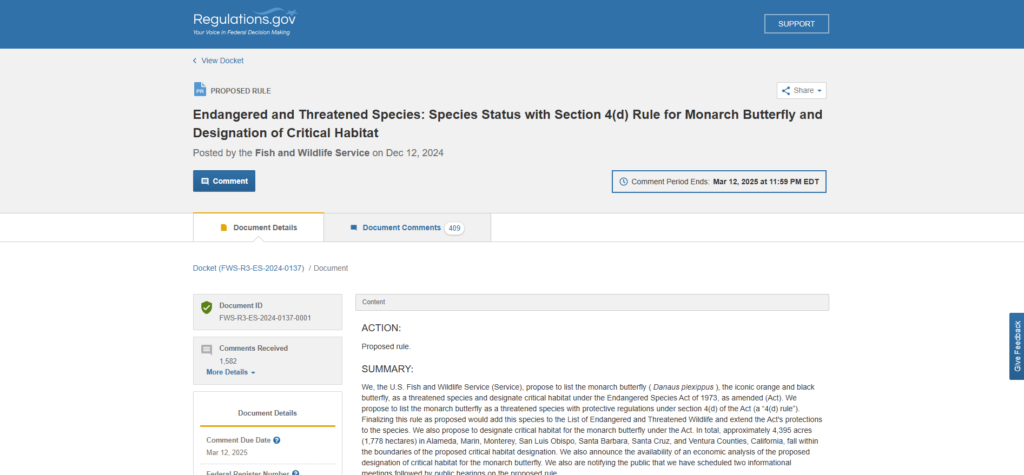
The U.S. Fish and Wildlife Service (USFWS) has proposed listing the monarch butterfly as a threatened species under the Endangered Species Act (ESA). This move aims to protect the iconic pollinator whose population has seen sharp declines over recent decades. For farmers, this proposal represents an opportunity to participate in shaping how agricultural landscapes and monarch conservation efforts can coexist. With the public comment period now open, farmers have a vital role in offering insights and suggestions. Here’s what you need to know to engage effectively with this process.
What Would A Threatened Listing Mean for Farmers?
A threatened listing under the ESA provides a level of protection that considers both the species’ conservation needs and practical accommodations for human activities. The proposed 4(d) rule for monarchs would allow farmers and landowners to continue specific agricultural activities while supporting monarch conservation efforts.
Key provisions for farmers under the 4(d) rule may include:
- Flexibility: Without a 4(d) rule, threatened species get all the protections that endangered species automatically get through Section 9 of the ESA. The 4(d) rule for a threatened species may change some or all of the section 9 protections. This might include allowing certain types of development, agricultural practices, or other activities that do not significantly harm the species.
- Tailored Protections: A 4(d) rule typically explains that certain expected activities are consistent with or contribute to a species’ overall conservation; therefore, even if those activities result in take of a threatened species, that take is not prohibited. If that take is not prohibited, then it does not require an exemption from the take prohibitions.
- Encouraging Proactive Conservation: Typically, USFWS uses 4(d) rules to incentivize positive conservation actions and streamline the regulatory process for minor impacts. As a part of those goals, the rule is often used to clarify or simplify what forms of take of a threatened species are and are not prohibited. By offering more flexible regulations, the 4(d) rule encourages landowners, farmers, businesses, and other stakeholders to engage in proactive conservation efforts.
Understanding these elements is crucial for farmers who want to weigh in on the proposal and ensure their perspectives are considered in the final rule.
How to Submit Comments on the Proposal
The public comment period runs until March 12, 2025, and your voice matters. Farmers are encouraged to share their observations, concerns, and recommendations directly with the USFWS. Submitting thoughtful and detailed comments can influence the final decision and implementation of the 4(d) rule.
Here’s how to submit your comments:
- Visit regulations.gov.
- Search for the docket number: FWS-R3-ES-2024-0137.
- Select the document titled “Endangered and Threatened Species: Species Status with Section 4(d) Rule for Monarch Butterfly and Designation of Critical Habitat” and click the “Comment”
What Makes a Good Comment?
The USFWS is looking for substantive comments that provide new insights or specific information. When submitting your input, consider the following:
- Personal Experience: Share how you’ve observed monarch populations or habitat trends on your land. Describe any challenges or successes in implementing pollinator-friendly practices.
- Data and Evidence: Include scientific studies, field observations, or statistics relevant to monarch conservation and agriculture.
- Suggestions for Improvement: Offer ideas on how the 4(d) rule could balance farming operations and habitat protection.
- Feedback on Impacts: Highlight how the proposed rule might affect your farming practices and suggest realistic solutions to address these concerns.
Opportunities to Learn and Engage
The U.S. Fish and Wildlife Service has scheduled two virtual public informational meetings followed by public hearings regarding the proposed listing of the monarch butterfly as a threatened species. These sessions are designed to provide an overview of the proposal, answer questions, and gather public input.
Meeting and Hearing Schedule:
- First Session:
- Date: January 14, 2025
- Time: 6:00 p.m. to 8:30 p.m. Eastern Standard Time (EST)
- Where: Zoom
- Register: Click here to register for the first session
- Second Session:
- Date: January 15, 2025
- Time: 8:00 p.m. to 10:30 p.m. EST
- Where: Zoom
- Register: Click here to register for the second session
The first portion of each session will be dedicated to providing information about the proposed listing and answering questions from participants. Following the informational meeting, a formal public hearing will be held to accept verbal comments. If you wish to provide oral comments during the hearing, please indicate this during the registration process.
Resources for Farmers
Farmers, landowners, and land managers will have access to resources and guidance from Farmers for Monarchs to help navigate the listing decision process and explore opportunities to participate in monarch-friendly programs that align with conservation goals. These resources are available through the ESA Listing Decision Toolkit on the Farmers for Monarchs website. There farmers will find blog posts, audio articles, a PowerPoint presentation, videos and other resources related to this listing decision.
